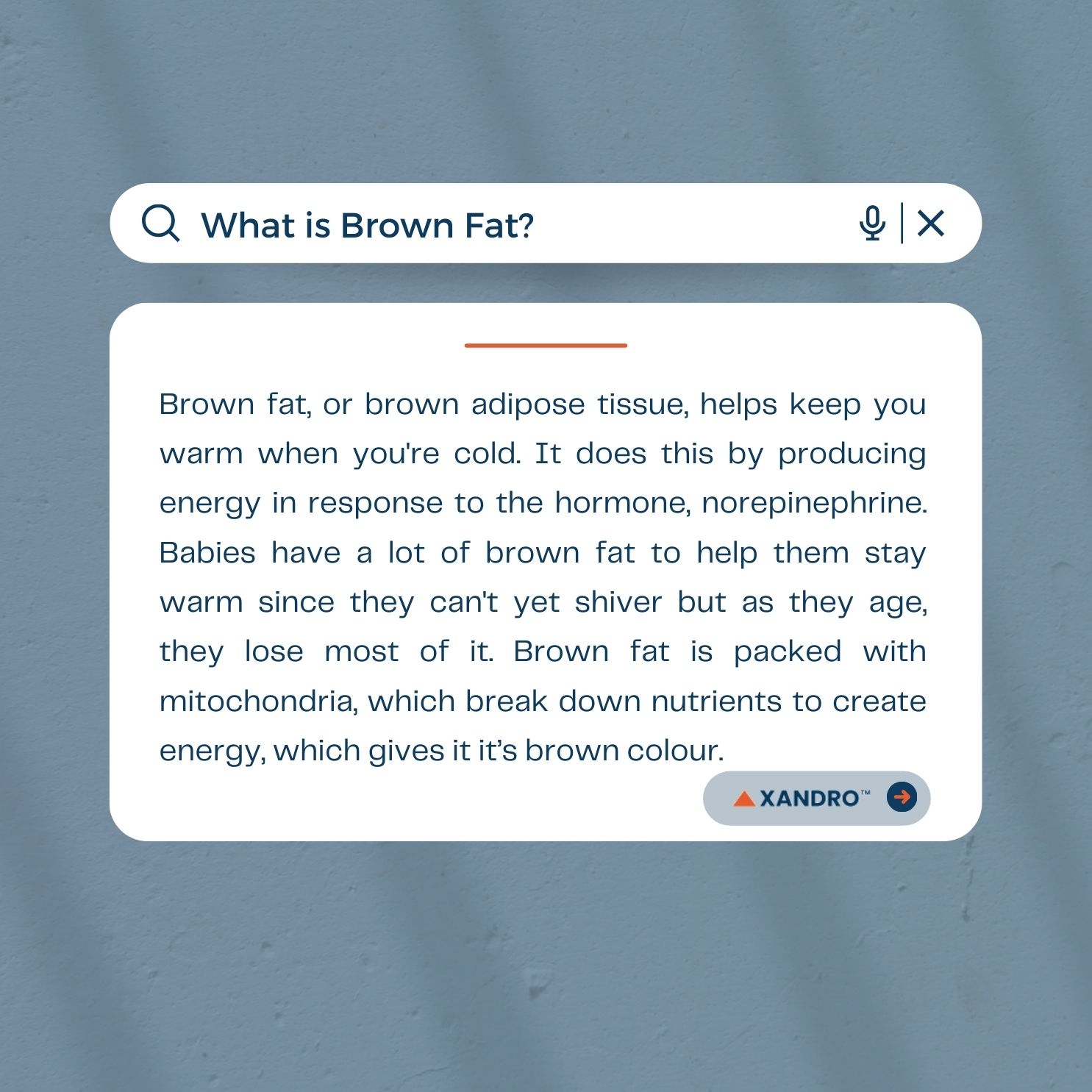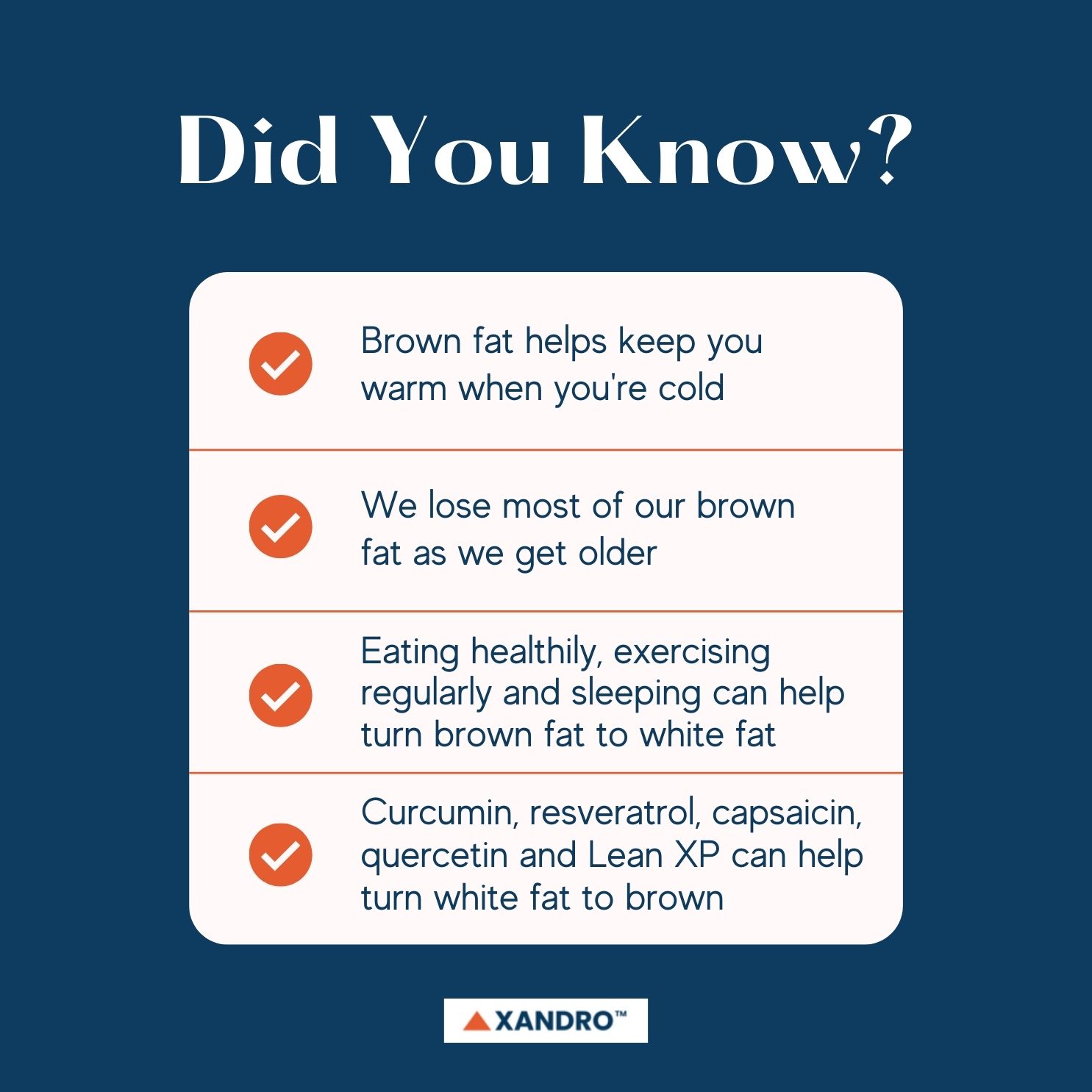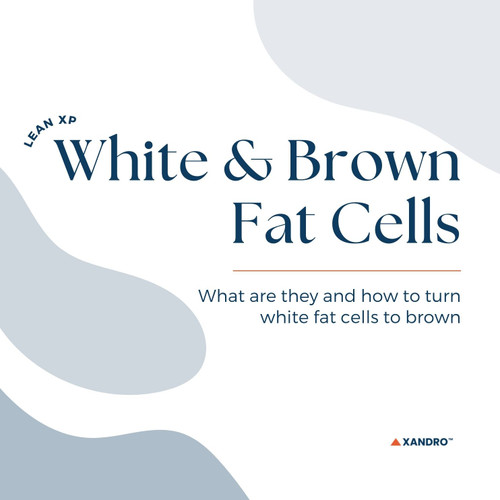What is Brown Fat and How It Differs From White Fat
29th Jul 2024
White vs Brown Fat Cells
Fat. It’s spoken about in various contents, such as weight and nutrition, but what exactly is it?
Fats, also known as fatty acids or lipids, are molecules in our body made up of three parts called triglycerides. While our bodies can produce most fats, some essential fats must be consumed through food, including omega-3 (found in fish and flaxseed) and omega-6 (found in nuts and corn oil).
When talking about fats, we generally hear about three main types of dietary fats: unsaturated fats (from plants), saturated fats (from animals) and trans fats (from processed foods).
But what about brown fat cells vs white fat cells?
Jump there now:
- What’s the Difference Between Brown vs White Fat Cells?
- Why Do We Need Fat?
- The Science Behind Brown Fat
- How to Break Down Fat Cells Quickly
- What Food Turns White Fat into Brown Fat?
- Xandro’s Lean XP
- FAQs
Brown fat, or brown adipose tissue, helps keep you warm when you're cold, similar to the fat bears use during hibernation. As babies, we have a lot of brown fat to help them stay warm since they can't shiver but then as we age, we lose most of this brown fat. Brown fat is packed with mitochondria, which break down nutrients to create energy and give brown fat its colour. Brown fat also stores more energy in a smaller space than white fat.
Which brings us to our second type of fat: white fat. White fat stores energy and extra calories and is found mainly in your thighs, hips and stomach. Too much white fat, especially around your belly, can increase the risk of heart disease and type 2 diabetes, so this is the fat people try to lose.
So, in terms of which is healthier, brown fat or white fat, brown fat is ‘healthier,’ but we still need white fat cells to be healthy.
Fat is important for staying healthy because it helps absorb vitamins (A, D, E and K), keeps our skin healthy and helps maintain heart health with essential fats like omega-3. Healthy fats from plant oils can also lower bad cholesterol, and, what’s more, fat also adds flavour to food and keeps you feeling full longer after a meal.
This is why it’s recommended to not eat very low levels of fat, but on the other hand, eating too much is also unhealthy and brings about a variety of health issues.
Now that you know more about white vs brown adipose tissue, let’s talk more about brown fat cells.

Brown fat helps keep you warm when you're cold by producing energy in response to the hormone norepinephrine. While we lose most of our brown fat as we get older, adults retain small amounts of brown fat in areas like the neck and spine, with lean people and women generally having more.
Scientists are studying how brown fat uses white fat for fuel and how exercise might activate brown fat. They're also exploring whether brown fat can be harnessed to treat obesity and related conditions like diabetes.
One study found brown fat filters certain amino acids from the blood, which in excess, are linked to obesity and diabetes. Researchers are also investigating if a drug could stimulate brown fat like cold does, potentially offering new weight loss methods.
Further Reading: Mitochondrial Health and Longevity
A new study has also found that brown fat has an ‘off switch’ that limits its effectiveness in treating obesity. Researchers discovered a protein called AC3-AT responsible for this switch-off mechanism. By blocking AC3-AT, they believe brown fat can be safely activated to help with weight loss and metabolic health.
In experiments, mice without the AC3-AT protein gained less weight and were healthier when fed a high-fat diet compared to control mice. This protein is also present in humans, suggesting potential therapeutic strategies for obesity!
Fat, or adipose tissue, is stored in several body areas, including under the skin (subcutaneous fat), on top of the kidneys, in the liver and in small amounts in muscle.
Men typically store fat in the chest, abdomen and buttocks, giving them that ‘apple’ shape, while women store it in the breasts, hips, waist and buttocks, giving them that ‘pear’ shape. These differences are due to sex hormones like estrogen and testosterone.
Fat cells form during the third trimester of pregnancy and puberty, but their number usually stays constant after puberty. When gaining weight, rather than fat cell development occurring, our existing fat cells enlarge rather than multiply, except in cases of significant weight gain or liposuction.
Subcutaneous fat is located in the lower body, while abdominal fat is primarily visceral. Visceral fat, which surrounds organs, is more harmful than subcutaneous fat. It releases cytokines that increase the risk of cardiovascular disease and affect insulin sensitivity, blood pressure and blood clotting. Also, visceral fat's proximity to the portal vein allows it to influence liver functions, leading to higher bad cholesterol and insulin resistance, which increases diabetes risk.
Losing belly fat involves exercise and diet, with physical activity being crucial. Fat, especially abdominal fat, acts as an endocrine organ, producing hormones that impact health. Excess body fat disrupts hormone balance and contributes to health issues like insulin resistance and cardiovascular disease.
To lose belly fat, regular moderate-intensity physical activity is so important — aim for at least 30 minutes a day and possibly up to 60 minutes. Strength training with weights can also help. Keep in mind that while exercises like sit-ups can tone abdominal muscles, they don't target visceral fat.
Diet is equally important. Focus on portion control and try to eat more complex carbohydrates (think fruits, vegetables and whole grains) and lean proteins over simple carbs (white bread, refined pasta and sugary drinks). Also, replace saturated and trans fats with polyunsaturated fats.
Although scientists are exploring drug treatments for abdominal fat, experts agree that lifestyle changes, especially exercise, are the most effective way to reduce visceral fat.
Did you know that white fat can be turned into brown fat?
This can be achieved by:
- Eating a healthy diet, including nuts and seeds, green tea, fibre-rich foods, avocado, fish, yoghurt, red chilli, berberine and red grapes.
- Exercising regularly
- Getting enough sleep
- Undergoing cold therapy
- Taking supplements
There are a range of supplements you can take that can help promote the process of turning white fat cells into brown fat cells, as well as helping to lose weight. These include curcumin, EGCG, resveratrol, omega-3 fatty acids, capsaicin, retinoic acid, quercetin, ginseng and oleuropein. Read our article about these below!
Further Reading: Compounds that Help Turn White Fat into Brown Fat

Looking for one of the best fat loss supplements? You’ll be happy to hear that Xandro Lab has is about to release one!
Lean XP is a carefully formulated, stimulant-free thermogenic supplement by Xandro Lab. It helps burn visceral belly fat, boost metabolism and support lean muscle growth without using caffeine, stimulants or steroids.
Benefits:
- Reduce Body Fat and Build Muscle: Converts white fat cells into calorie-burning brown fat cells.
- Boost Energy Levels: Provides a natural energy boost without crashing.
- Reduce Sugar Cravings: Helps manage cravings to help with your weight loss goals.
- Promote Healthy Metabolism: Improves overall metabolic health.
Scientific-Backed Ingredients:
- ThinOgen® Laminaria Japonica Extract: Boosts metabolism and supports weight management.
- MitoBurn® (L-β-Aminoisobutyric Acid): Improves exercise effects and fat loss.
- Garcinia Cambogia Fruit Extract: Suppresses appetite and blocks fat production.
- L-Carnitine: Improves fat burning and energy production.
- Ca-AKG (Calcium Alpha-Ketoglutarate): Supports energy production and muscle performance.
- CaloriBurn GP® (Grains of Paradise Extract): Boosts metabolism and calorie burning.
What is the difference between white and brown adipose cells?
White adipose cells store energy as fat and are the most common type of fat in the body. They appear white or yellowish because they contain a single large fat droplet. Brown adipose cells, on the other hand, burn energy to produce heat. They are brown due to the high number of mitochondria, which are rich in iron and help generate heat.
What foods are high in fat to kill cancer cells?
Certain foods high in healthy fats, like omega-3 fatty acids, may help fight cancer. These include fatty fish (such as salmon and mackerel), flaxseeds, chia seeds, walnuts and olive oil. These fats can reduce inflammation and support overall health, but they are not a cure for cancer.
Does fasting turn white fat into brown fat?
Fasting can promote the conversion of white fat into brown fat. This process, called "browning," helps the body burn more energy and generate heat. However, the extent of this conversion can vary based on individual metabolism and the length of the fasting period.
Further Reading: Intermittent Fasting and Longevity
Does freezing fat cells help with fat burning?
Freezing fat cells, known as cryolipolysis can help reduce fat in targeted areas. This process destroys fat cells by exposing them to very cold temperatures, and the body gradually eliminates them over time. While it helps with fat reduction, it's not the same as burning fat for energy.
What are fat cell organelles?
Fat cell organelles are specialised structures within fat cells (adipocytes) that perform various functions. These organelles work together to store energy, regulate metabolism and produce heat. Key organelles include:
- Mitochondria: Produce energy and are abundant in brown fat cells.
- Lipid Droplets: Store fat in white fat cells.
- Endoplasmic Reticulum: Produce proteins and lipids.
- Nucleus: Contains the cell's genetic material and regulates its activities.
